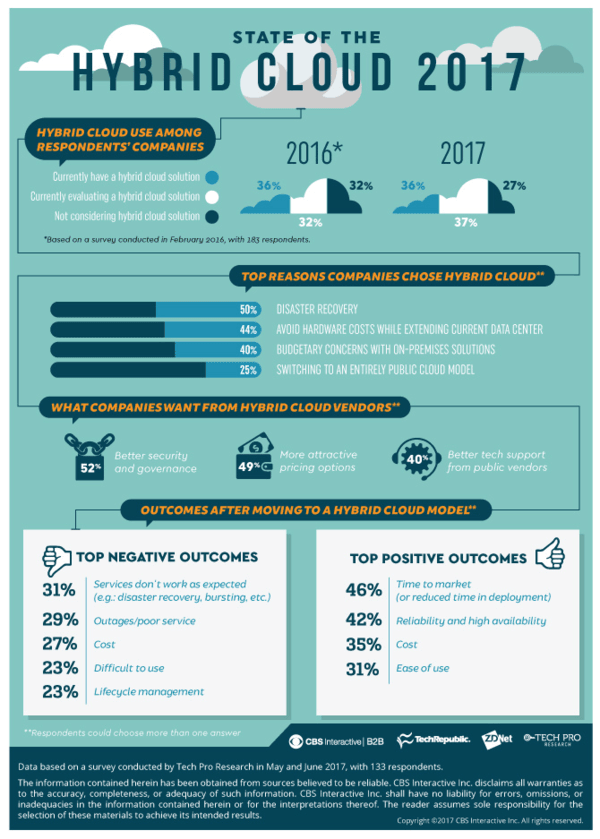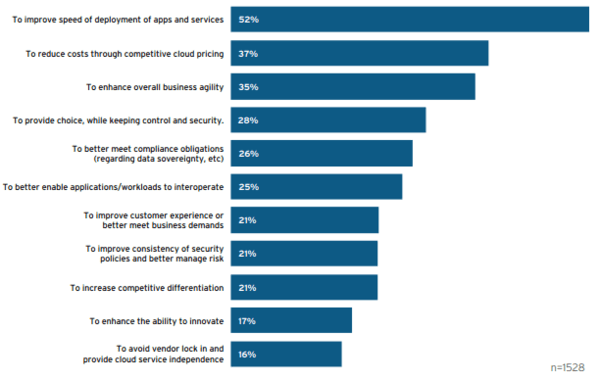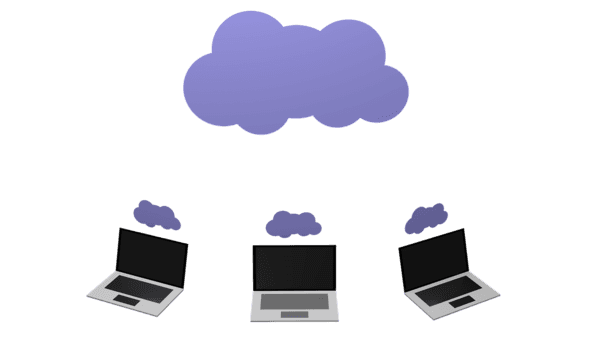
What Is a Raspberry Pi?
October 18, 2018
10 Tools to Prevent DDoS Attacks
October 24, 2018As more companies and organizations look to incorporate cloud computing in their IT infrastructure, the hybrid cloud has emerged as a popular option. This article addresses the issue of whether the hybrid cloud is the right choice by examining its pros and cons and highlighting the reasons why an organization would opt for such a setup. You’ll also get some practical advice on overcoming some of the main challenges presented by a hybrid cloud implementation.
What Is the Hybrid Cloud Approach?
The National Institute of Standards and Technology (NIST) defines the hybrid cloud deployment model as a combination of two or more cloud types wherein each member remains a unique entity, but is bound to the others through standardized or proprietary technology that enables application and data portability. https://www.youtube.com/embed/UGryoLpCA7MThe two cloud types combined by the majority of organizations in a hybrid setup are public and private clouds. In the public cloud, computing resources and services are made available to users via a public Internet connection and the infrastructure is shared.
In a private cloud, clients provision a dedicated computing environment for their own use. The private cloud environment could be hosted on-premise or in an off-site location, but only one client can access it via a private connection.
Bearing in mind the unique challenges of cloud migration for any organization, it is worth clarifying why stakeholders might view such any sort of cloud deployment as a worthwhile venture. Broadly speaking, cloud computing offers a slew of benefits, including improved efficiency, cost savings, and easier scalability of existing systems.
As for specific motivations for choosing a hybrid cloud model, some important use cases include:
- Using the private cloud to deploy applications to production while reserving public cloud use for application development and testing.
- Cloud bursting, which means dynamically moving your private cloud applications to a public cloud deployment during periods of increased demand or unexpected usage spikes.
- Running mission-critical apps in a private cloud but using the public cloud for disaster recovery purposes in the event of an unexpected outage in on-premise/internal computing environments.

Hybrid Cloud Pros and Cons
Pros
Better Business Continuity/Disaster Recovery
When you go “all-in” on one type of cloud, you are at the mercy of that specific environment. You might find it tougher to recover from cloud infrastructure failures in these cases, and business continuity suffers. If you build out your own private cloud and it fails, how would you recover with no backups? If you rely solely on public cloud services, what happens if your vendor suffers an outage?
With the hybrid cloud, by definition, you aren’t reliant on a single cloud environment to serve your important IT functions. Furthermore, the pay-per-use model of the public cloud makes it ideal to use for business continuity purposes, making failover to a secondary location during an outage a much more accessible option than ever. Research shows that 56 percent of organizations believe the hybrid cloud model improves disaster recovery.
Cost Savings for Specific Projects
Any organization that wants the control that comes with having its own private cloud faces a dilemma when it comes to temporary and specific workloads that their existing infrastructure can’t handle. Consider an organization looking to conduct a big data analytics project. The capital costs for extra servers and storage to support a Hadoop cluster on-premise quickly become prohibitive.
With the hybrid cloud, organizations can maintain the control they desire over their mission-critical apps and storage in the private cloud while leveraging the immense scalability of public cloud infrastructure at a fraction of the cost for specific projects like big data analytics that are computationally intensive.
Unique Balance of Control, Performance, and Scalability
You get the control over important data and apps and the level of performance required from the private cloud while the public cloud is there to augment your workloads and provide additional scalability if necessary. The hybrid cloud is the best of both worlds.

Cons
Security Complexities
While cloud vendors do their best to secure their environments, the responsibility for security in the hybrid cloud ultimately falls to your business. The nature of a hybrid cloud model introduces additional security complexities, such as identifying hidden vulnerabilities between the two cloud types and ensuring uniform user authentication and access across public and private clouds.
Possible Bottleneck
The possibility of a network bottleneck exists when transferring data between private and public clouds. The transfer to the public cloud is done via the public internet and transfer might be too slow to meet enterprise IT needs. For mission-critical functions or apps, this slowdown can quickly become untenable in terms of its negative impact on performance.
Lack of Visibility

It is more difficult to maintain visibility over cloud usage in a hybrid cloud implementation. The lack of visibility can cause costing issues, with organizations leaving idle instances running or using unsuitable cloud storage options.
The lack of visibility can also affect compliance with regulations as data moves between internal and external systems, and organizations might not be certain their public provider is compliant with important regulations.
Overcoming Hybrid Cloud Challenges
Some best practices to overcome the challenges of a hybrid cloud model are:
- Encrypt data in the cloud.
- Take responsibility for security instead of leaving it to your cloud vendor(s).
- Create and document policies regarding the appropriateness of each type of cloud for specific apps, data, and workloads, bearing in mind performance, regulatory requirements, and whether the given function is mission-critical.
- Incorporate automation where possible, such as by using predictive auto-scaling solutions.
- Ensure you either have a cloud expert at your disposal or you hire one to help assist with a smooth implementation.
- Look for public providers that offer a direct connection to their systems from your on-premise infrastructure.
Wrap Up
Bearing in mind that the challenges and the cons of the hybrid cloud can be addressed by organizations using a combination of careful planning and best practices, it is clear that the hybrid cloud is an excellent option with unique use cases and benefits.
